2016 Activity Report
March Activity Report
March 2017
Global Japan Office Coordinator
Taguchi Kazumi
For the March report, I am featuring a brief insight into a class at SOAS.
I wrote about our visit to the SOAS Minyo Group last summer. At the time, I heard that there would be an introduction and demonstration of Tusgarujamisen at one of the classes in the Music Department. I got permission and attended the class.
The class is called ‘Music and Traditions of East Asia’, taught by a Senior teaching fellow and Leader, Dr. Ruard Absaroka. He kindly accepted my request and let me join his class.
The teacher who gave the demonstration of Tsugarujamisen is Mr. Hibiki Ichikawa, who is active in promoting Tsugarujamisen in Europe and many other places, he was accompanied by one of his pupils, Miss Martina Kopp, who is a leader in the Berlin group.
After receiving a certificate from his teacher to teach Tsugarujamisen, Hibiki Ichikawa came to London with the mission of spreading and popularising Tsugarujamisen in Europe. Since his arrival in London, Hibiki Ichikawa has participated and played in many events (for example, Japan Matsuri, Hyper Japan, events at Japanese Embassy in London to name a few). Along with his performance activities, Hibiki Ichikawa began to teach Tsugarujamisen. In 2013, he taught Tsugarujamisen at the SOAS World Music Summer School which was a short one week course. Since then, he has been teaching passionately in many places and expanding the number of his students. He has over 25 students in London now. Since 2015, he began to hold a workshop in Berlin named Sham-camp and it is planned to have it annually.
Hibiki Ichikawa has just released a second CD of his music. He has also collaborated with other musicians and performers, played Tsugarujamisen in a play in a theatre in Edinburgh, and most recently he took part in playing Tsugarujamisen music and sounds in the animation film produced by Laika titled “Kubo and the Two Strings”.
I asked Hibiki Ichikawa what are the interesting points of promoting Tsugarujamisen in Europe? Are there any difficulties in teaching?
Hibiki Ichikawa answered “I want to create as many opportunities as possible for people in London, which is one of the major international cities, to hear the sound of the Shamisen which was born in Japan.” “Regarding teaching, I am excited by witnessing my students improve their skills in playing day by day, which gives me an enormous pleasure!”
In that day’s class for SOAS students from many different nationalities, Hibiki Ichikawa gave a demonstration together with his student from Berlin, Martina, playing some traditional tunes as well as his own original tunes which had a flavour of Middle Eastern tones. He also gave explanations for the background of the tunes so that students could have a better understanding of the music.
After the demonstration, it was a time for students to experience playing. A few students tried playing with instructions given by Hibiki. They could play very well with little instruction, as they are music students and have a good understanding of playing instruments. On the other hand, Tsugarujamisen is a string instrument like a guitar, but is played with a huge plectrum. How to handle a huge plectrum whilst playing looked difficult.
There was a question time at the end of the class. There were many questions such as scale, what a plectrum was made of, what are the differences compared with other type of Shamisen, when did he begin to play the instrument. Hibiki who has a sense of mission to spread Tsugarujamisen answered each question carefully.
The theme of this month’s report was “the introduction of Japanese culture through music lessons”, and I realized that it is hands on experience of seeing and listening that is the most important and best way of understanding a different culture.
I would like to thank Dr. Ruard Absaroka who organized the demonstration for the class and the teacher of Tsugarujamisen, Hibiki Ichikawa and his student, Martina Kopp, for their cooperation in my writing this article.
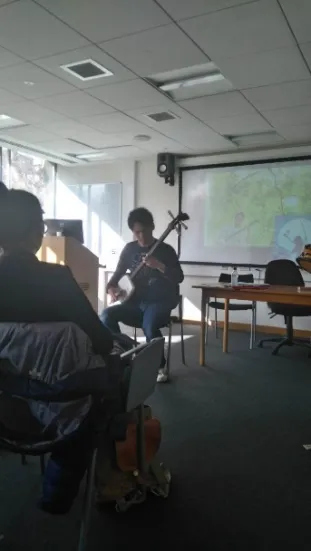
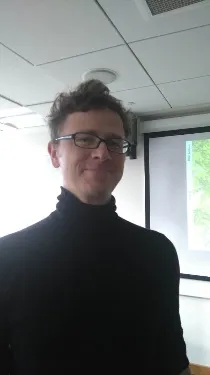
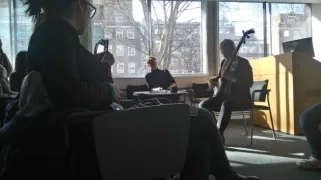
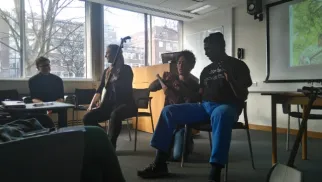
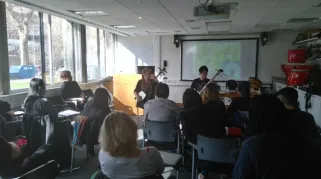
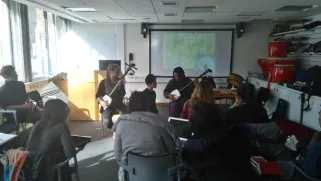
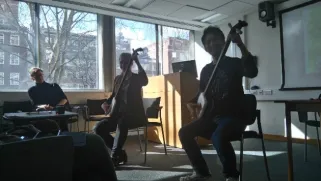
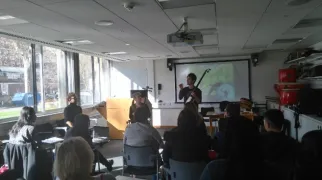
February Activity Report
February 2017
Global Japan Office Coordinator
Taguchi Kazumi
【Exchange Student Meeting Between TUFS and SOAS】
At the beginning of the month, I started to plan and prepare for the second TUFS-SOAS students cultural exchange event.
We decided the title of the event would be “Ehomaki Taikai”, as TUFS students expressed an interest in celebrating Setsubun and eating Ehomaki.
For our second event, we thought it would be better to book a classroom in order to have more private space. We managed to book a classroom with great help from the Head of Administration at Language and Culture and one of the SOAS students, Afsheen.
Two new students who are going to study at TUFS from September also joined us. They were introduced to us by Dr. Furukawa at the Japanese Language Department.
The Ehomaki event started with a lecture given by Professor Arakawa of ILCAA, TUFS on his area of research, the Xi Xia language.
I was about 10 minutes late due to taking time preparing the ingredients for Sushi at home. By the time I joined the class, the classroom was full.
The students were listening with great interests to the talk given by Professor Arakawa who explained the Xi Xia language with passion and in a manner which was easy to understand for beginners.
In total, there were five students from TUFS and 6 students from SOAS. (unfortunately, the student who helped booking the classroom had to leave early as he had to attend another talk.)
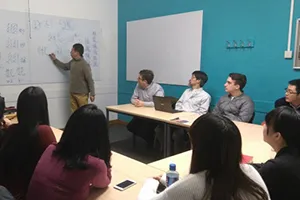
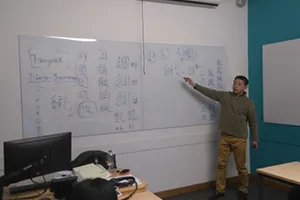
Professor Arakawa’s talk on Xi Xia language
After Professor Arakawa’s talk, we moved on to the Ehomaki event.
First of all, we began to set up the room for Ehomaki, spreading the table cloth creating a space to demonstrate making Rolled Sushi. Everyone eagerly cooperated and we finished setting up fairly quickly.
It is said that there is a tradition of eating Ehomai at Setsubun, which is a seasonal event to mark the transition of the seasons. Eating Ehomaki on Setsubun as a tradition doesn’t have a clear history and it is rather mysterious. There is one hypothesis that there was a promotion of eating big rolled sushi created by a group of Sushi Restaurants in 1970 which was spread by the media. Ever since, it has become a custom.
I started off demonstrating how to roll Sushi, so that anyone who wanted to try had some idea of what to do.
I placed the ingredients, Sushi rice, Nori, Sushi vinegar at the side, and set out disposable gloves for everyone to wear so as to be hygienic and not make a mess in the classroom.
Everyone watched the demonstration with focused concentration.
It was a first time to experience of making Ehomaki for the SOAS and TUFS students and Professor Arakawa. It was amazing how fantastic they were as Sushi chefs.
After making it, it is natural to cut the roll of sushi into small pieces. However, for Ehomaki it is different. Due to superstition, you are supposed to eat one whole Sushi without cutting it. It is a food for receiving good luck, so it is better to avoid cutting it, as you may cut off your good luck. You are also meant to make a wish whilst you are eating.
Whilst making Sushi, the students enjoyed speaking to each other. I hope the Ehomaki event provided an opportunity for everyone to experience Japanese culture directly.
One of the SOAS student who will be studying at TUFS in September rises to the challenge of making sushi. Beside him, his classmate who is also going to TUFS is giving him emotional support.
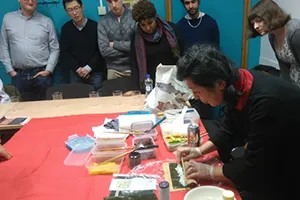
My demonstration on how to make rolled sushi
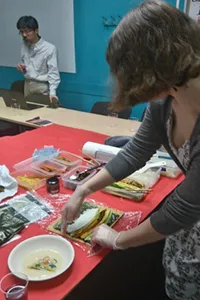
A SOAS third year student showing confidence in making sushi SOAS
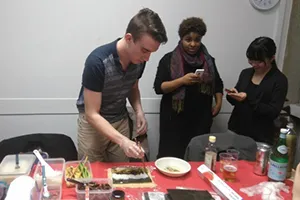
No problem using chopsticks! it.
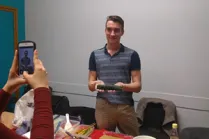
Here, he made it.
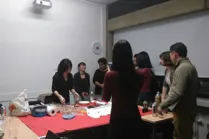
A TUFS student also has a go at the challenge!
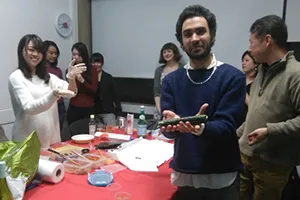
A TUFS student has just made sushi for a SOAS student.
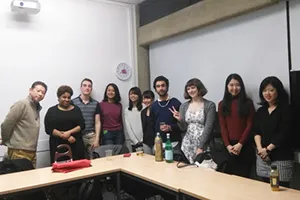
A souvenir photo of Professor Arakawa’s talk and the Ehomaki event
November Activity Report
November 2016
Global Japan Office Coordinator
Taguchi Kazumi
We had the first SOAS-TUFS exchange students’ meeting starting from early evening on the 18th of November. The participants were 5 TUFS students and 3 SOAS students, in total 8 students.
We assembled at The Institute of Education (UCL) at 6 pm. It was a Friday night, so there were many students in the hall and we had some difficulty in finding a table and chairs.
The meeting began with a self-introduction using the language of the student’s own subject area, followed by the reasons for their choosing that particular subject area. Then, it developed into explaining detailed information about their studies and their future study expectations.
The hall was full of people and there was a lot of noise but despite this difficulty, everyone was fascinated by each other’s speech and listened carefully with great enthusiasm.
After the presentation, opinions were exchanged on many different subjects and finally we took a few pictures to remind ourselves of the occasion for later.
After the photo session, we began to converse informally and had some homemade sushi made by myself.
The evening went very pleasantly and we look forward to the next one which will be sometime in the new year.
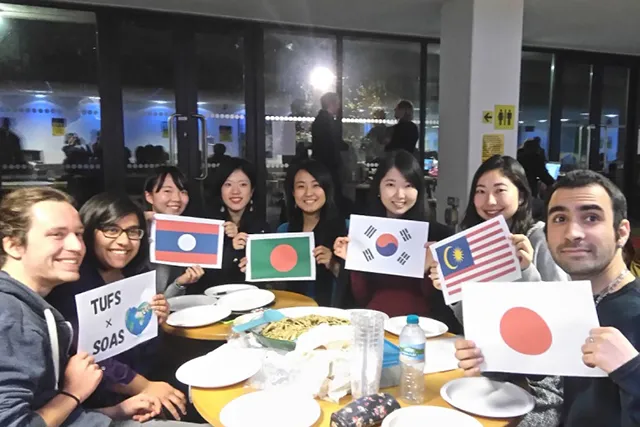
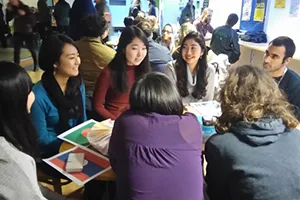
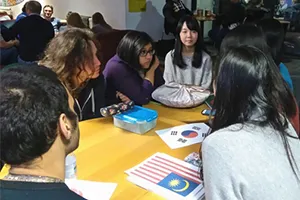
October Activity Report
October 2016
Global Japan Office Coordinator
Taguchi Kazumi
I joined to the first meeting held by the SOAS Japan Society on the 20th of October at IOU (Institute of Education) which is a part of UCL. There were many students gathered at the meeting.
There were a few students from TUFS and they had a great time talking to SOAS students.
We are going to have a TUFS/SOAS event in November.
The New Academic Year has started and I attended the Freshers Fare on the 1st of October where new students were welcomed and signed up to all sorts of society activities.
It was the first weekend after registration and the school was full of new and old students.
The new students experiencing their first weekend before the start of classes the following week, were keen to have a look around to find out what was on offer. They looked excited and a little anxious at the same time. There are many reasons for joining the many societies on offer, such as pursuing hobbies and developing friendships.
A huge range of activities were available in the three locations allocated to general societies, music and entertainment related societies and sports societies.
It was amazing to see such a large number of activities relating to so many different nationalities, a quintessential characteristic of SOAS. All these societies representing different nationalities were passionately explaining what their societies were about to the students.
I as a coordinator was keen to learn about the activities of the Japan Society. I registered with them and waited for their mail to inform me about the first meeting.
I joined to the first meeting held by the SOAS Japan Society on the 20th of October at IOU (Institute of Education) which is a part of UCL. There were many students gathered at the meeting.
There were a few students from TUFS and they had a great time talking to SOAS students.
We are going to have a TUFS/SOAS event in November.
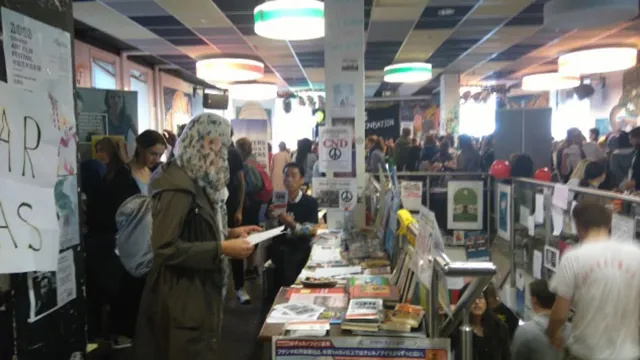
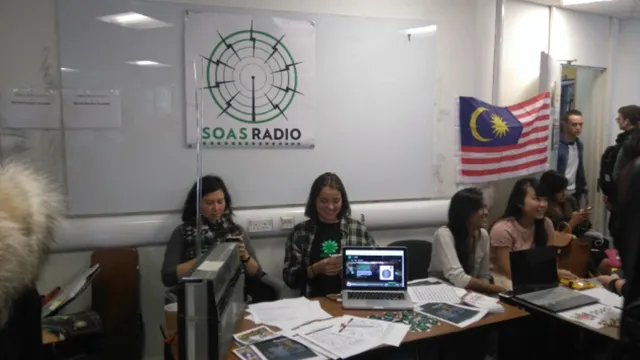
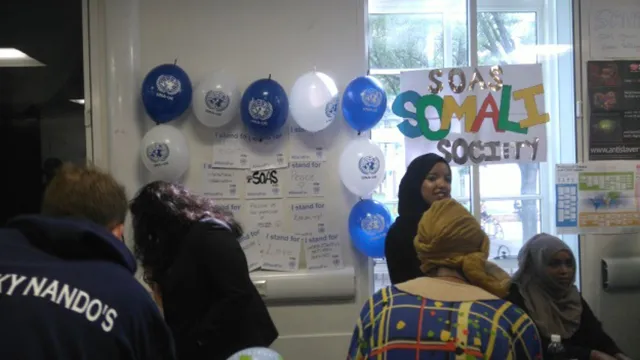
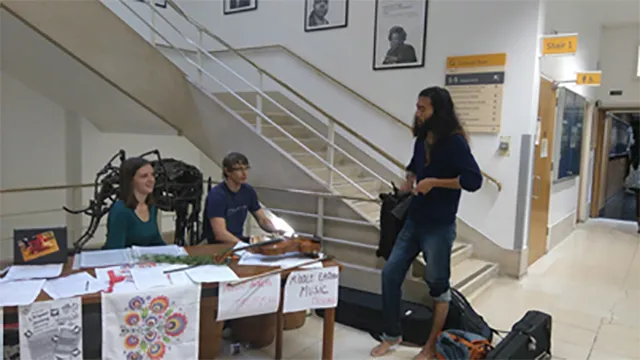
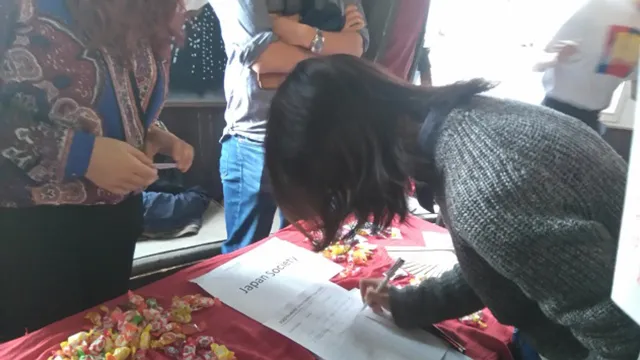
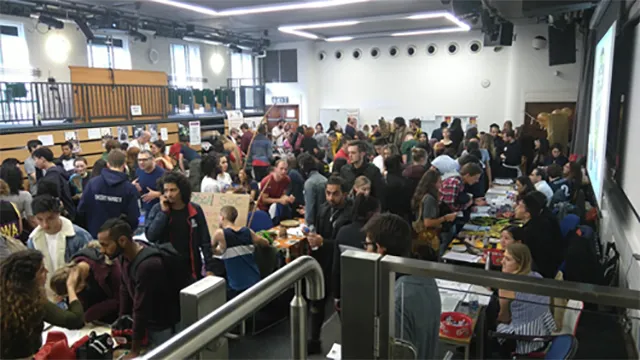
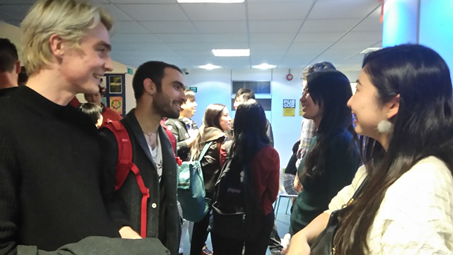
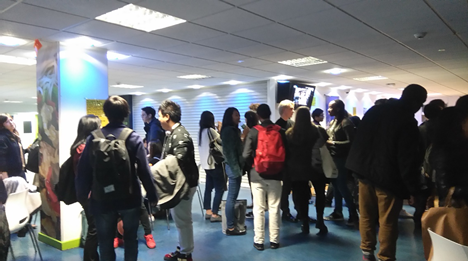
August Activity Report
August 2016
Global Japan Office Coordinator
Taguchi Kazumi
Hello, everyone. My name is Kazumi Taguchi, and I have started to work as the TUFS Coordinator at London SOAS office in July.
I will briefly introduce myself.
My relationship with SOAS has been a long one, and I feel that SOAS is almost like my home in the UK.
I began in 1988 by taking a one-year intermediate certificate course in the external division of SOAS.
I then went on to study Music and History for my BA and Chinese Studies for my MA. I have just submitted my PhD thesis to the department of Religions and Philosophies. My thesis looks at Soseki’s religious views by analysing his Kanshi compositions.
As a hobby, I play music and belong to a number of SOAS music societies; SOAS Okinawa Sanshin kai, SOAS Royal Holloway Noh Group, SOAS Korean Drumming Society, and London Youlan Qin Society.
I am interested in the relationship between Britain and Japan which has existed for over 450 years, and in working for the maintenance and development of understanding, cooperation and friendship between the two countries.
【Exchange Student Meeting Between TUFS and SOAS】
2016 Summer Project: visiting SOAS Minyo group to the Ethnomusicology Department:
On the 13th of August, the beginning of an annual national event, the Bon festival, we made a visit to the classroom of the SOAS Minyo group which has been very active in performing and is led by Ethnomusicologist, Dr. David Hughes who we met.
The Minyo group were vigorously preparing and finalising their set in order to participate in the Japan Festival held at Sheffield in the north of England the following week. The group is very popular and have performed in many Japan related events over the years in the UK and Europe. The Minyo group give an impression of being very friendly, but at the same time extremely professional in their singing, playing of instruments, dancing and presentation.
The visiting members were Mr. Koinuma from the TUFS administration office on the SOAS-TUFS Global Adminstrative Exchange Programme, a TUFS student, a Tokyo University student, and a Nagoya University student. They participated in the practice by clapping hands and chanting to keep time, as well as giving encouragement and joining in on some singing.
It seemed to me that it was difficult for the Japanese visitors to imagine the concept of traditional Japanese folk songs (Minyō) as a part of ethnic music prior to our visit. However, once they entered the class room and had a big welcome from the group, they relaxed immediately (it seemed to me). The Japanese visitors witnessed how all the members almost all of them non-Japanese sang and played Minyo passionately from the heart, which made the Japanese visitors clap hands and chant enthusiastically with the help of Dr. Hughes who provided them with song sheets.
I am pleased, if the visit to the Minyo class at SOAS Music department has offered a chance to learn how the Japanese culture has been introduced, received and maintained outside Japan to students who will be the future generation and play an active part in the international environment.
There was a picnic after the class at Russell Square, and Mr. Koinuma from TUFS administration office attended on behalf of us all. According to Mr. Koinuma, it was very relaxed and friendly, everyone having a nice time singing and dancing. I would like to express my gratitude to Dr. David Hughes, Professor Gena Barns, and all the members of Minyo group for their cooperation, friendship, and warm welcome in enabling the 2016 TUFS London Summer event to take place.
The New Academic year will start in October. I hope to plan and realise more events for SOAS-TUFS students to exchange their ideas.
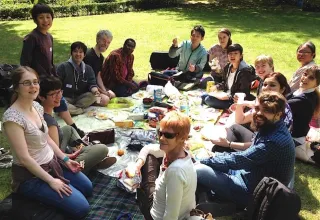
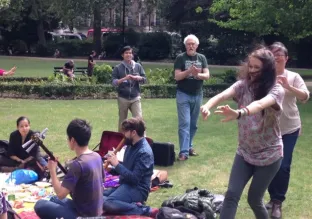
Minyo group and TUFS visitor sing and dance Tankō Bushi at the Picnic at Russell Square celebrating the OBON Festival.
